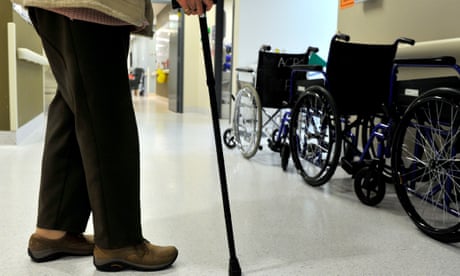- by foxnews
- 09 Mar 2025
‘I can’t leave her there to get Covid’: home care demand soars amid aged care crisis
‘I can’t leave her there to get Covid’: home care demand soars amid aged care crisis
- by theguardian
- 13 Feb 2022
- in news

Cathy Beaufort knows she should be touring nursing homes to find an appropriate facility for her 95-year-old mother but "there's absolutely no way on the planet that I want her to go to aged care".
"How could I put her into care?" Beaufort says from her mother's home, which she travels an hour to from her Brisbane home multiple times a week to provide care. The 14 hours of care provided by two home care workers is not enough, but is all she is eligible for under a home care package.
Beaufort's mother is mentally healthy; her heart and lungs are strong. But a catastrophic complication during back surgery means her mobility is extremely limited and worsening, placing her at risk of falls.
"I'm 64 [and] I've been caring for her for 10 years. Her needs have increased and I am so tired," Beaufort says. "But even though she is triple-vaccinated, what will it mean for her if she goes into aged care and Covid gets into the home? They might put her in isolation, which means I can't visit."
Beaufort says she has been reading stories about the atrocious conditions and staff shortages ravaging aged care homes.
"I can't send my mother off to an aged care facility and potentially not even be able to visit her, or leave her there to get Covid."
Georgia Downes, the chief operating officer of Home Instead Australia and New Zealand, says home care demand skyrocketed throughout the pandemic as people were desperate to avoid aged care facilities.
"Between the combination of Covid and the aged care royal commission, we've seen a 65% increase in inquiries for our services since April 2020," Downes says.
Demand spiked again with Omicron, she says, but staff shortages across the sector combined with international border closures meant meeting the need has been challenging.
Unlike the aged care sector, the home care industry does not have access to the national personal protective equipment stockpile or the surge workforce.
Home Instead has developed its own education program for carers and is a registered training organisation. It encourages people who are compassionate and caring to apply.
"We've decided that we're not going to wait for the government to fund more training for more caregivers."
In Victoria, the CEO of Australian Multicultural Community Services (AMCS), Elizabeth Drozd, wrote to the minister for aged care services, Richard Colbeck, on 20 January to ask what the government's plan was to support the growing demand for home care. She is yet to receive a reply.
AMCS provides home support services to Victorian seniors from diverse backgrounds.
"It has been demanding to meet vulnerable clients' needs without enough employees to provide and facilitate services," she wrote to the minister.
Guardian Australia has contacted Colbeck's office for comment.
Drozd told Guardian Australia that in October the provider lost 15% of its direct care staff due to vaccine mandates, though she encouraged as many as possible to get vaccinated. She also lost staff who were afraid of contracting Covid.
"We could employ 50 people today, at least," Drozd said. "But where are we going to get the people? Migration and students' intake has reduced in the last two years.
"And yet there's no plan from the commonwealth government, despite the royal commission and Productivity Commission preparing reports saying more workforce shortages in aged care are coming."
Adding to pressures is a rise in inquiries from the community from people wanting to leave aged care facilities for home care, Drozd said.
"We have been growing 40% in terms of the number of clients wanting us to assist every year, and it's absolutely because of the confronting issues from the royal commission and images coming from aged care. I had such a distressed woman call me before Christmas because we did not have the resources to support her mother who was palliative and was set to go into a facility. We just couldn't do it.
"One of the worst days was when we had 73 of our own clients on the 3rd of December who we could not support, we had no capacity.
"Because of homes locking down due to Covid, once people go into palliative care in a facility, their family members worry may never see them again in their last days of their lives."
Palliative Care South East in Victoria provides care to people in nursing homes but also in their own homes. CEO of the service, Kelly Rogerson, says in the first three weeks after Christmas, as Omicron spread, she thought: "Oh my goodness, how are we going to survive?"
"We had 50% of our staff furloughed on one day, and then to 25% on most days during that first couple of weeks of spread. But everyone from administration to senior management worked so hard to keep everyone supported."
Rogerson says aged care facilities restricting visitors to the elderly in the last days of their life to avoid Covid spread was leading to thousands of people traumatised by a feeling they were unable to give their loved ones a proper goodbye.
This was creating unprecedented demand for home care palliative services. In 2018, the service admitted 762 clients, and in 2020 this rose to 1,241 people, much of that driven by home care requests.
Beaufort says trying to decide what the best thing to do for her mother is harrowing. She is angry that families have been left to struggle as they try to manage the risks posed to their elderly loved ones by Covid, while trying to ensure appropriate care for them in their final years or days of life.
"The politicians have decided to open up before aged care was equipped, and as a result, they've shifted the risk onto the most vulnerable," she said.
- by foxnews
- descember 09, 2016
'Speaker scum' on flights sparks debate among travelers: 'This is getting out of hand'
A traveler asked social media users to weigh in on flyers who play audio aloud on their devices and don't use headphones.
read more


